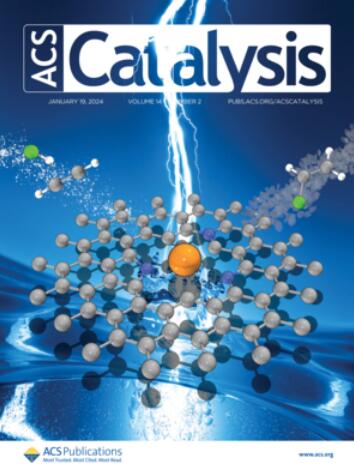Oxygen and Hydrogen Mass-Transfer Between O2, H2O and Lan+1NinO3n+1 (n = 1, 2, 3): 16O/18O Isotope Exchange and Electrochemical Impedance Spectroscopy Study
IF 13.1
1区 化学
Q1 CHEMISTRY, PHYSICAL
引用次数: 0
Abstract
The mass-transfer of oxygen and hydrogen between the gas phase containing humidified O2 and the Lan+1NinO3n+1 (n = 1, 2, 3) electrode in contact with the proton-conducting La28–zW4+zO54+1.5z (LWO) electrolyte has been studied. The measurements were performed using the 18O pulse isotope exchange (PIE) technique in the temperature range of 350–800 °C under a flow of He + O2 in both dry and humid conditions. Electrochemical studies were carried out using electrochemical impedance spectroscopy (EIS) within the temperature range of 600–800 °C in humid air. The PIE study demonstrated that all Lan+1NinO3n+1 oxides exhibit oxygen surface exchange with O2 and H2O, and the results were further justified by 1H NMR and TGA studies. The mechanism of oxygen surface exchange is discussed. EIS measurements revealed two distinct surface exchange processes for the La3Ni2O7−δ and La4Ni3O10−δ electrodes in contact with LWO, which is explained by the two-step mechanism proposed on the basis of the PIE studies. The EIS and PIE results showed that the hydration of La4Ni3O10−δ occurs through the interaction of oxygen with water on the electrode surface in a humid atmosphere, leading to the formation of hydroxyl groups and their subsequent incorporation into structural oxygen vacancies.O2、H2O与Lan+1NinO3n+1 (n = 1,2,3)之间的氧、氢传质:16O/18O同位素交换及电化学阻抗谱研究
研究了含有湿化O2的气相与与质子导电La28-zW4 +zO54+1.5z (LWO)电解质接触的Lan+1NinO3n+1 (n = 1,2,3)电极之间氧和氢的传质。采用18O脉冲同位素交换(PIE)技术,在350-800°C的温度范围内,在干燥和潮湿条件下的He + O2流下进行测量。利用电化学阻抗谱(EIS)在600-800℃的潮湿空气温度范围内进行了电化学研究。PIE研究表明,所有的Lan+1NinO3n+1氧化物都与O2和H2O进行了氧表面交换,1H NMR和TGA研究进一步证实了这一结果。讨论了氧表面交换的机理。EIS测量结果表明,La3Ni2O7−δ和La4Ni3O10−δ电极在与LWO接触时发生了两种不同的表面交换过程,这可以用PIE研究的两步机制来解释。EIS和PIE结果表明,La4Ni3O10−δ的水化是在潮湿大气中通过氧与电极表面的水相互作用发生的,导致羟基的形成并随后进入结构氧空位。
本文章由计算机程序翻译,如有差异,请以英文原文为准。
求助全文
约1分钟内获得全文
求助全文
来源期刊

ACS Catalysis
CHEMISTRY, PHYSICAL-
CiteScore
20.80
自引率
6.20%
发文量
1253
审稿时长
1.5 months
期刊介绍:
ACS Catalysis is an esteemed journal that publishes original research in the fields of heterogeneous catalysis, molecular catalysis, and biocatalysis. It offers broad coverage across diverse areas such as life sciences, organometallics and synthesis, photochemistry and electrochemistry, drug discovery and synthesis, materials science, environmental protection, polymer discovery and synthesis, and energy and fuels.
The scope of the journal is to showcase innovative work in various aspects of catalysis. This includes new reactions and novel synthetic approaches utilizing known catalysts, the discovery or modification of new catalysts, elucidation of catalytic mechanisms through cutting-edge investigations, practical enhancements of existing processes, as well as conceptual advances in the field. Contributions to ACS Catalysis can encompass both experimental and theoretical research focused on catalytic molecules, macromolecules, and materials that exhibit catalytic turnover.
 求助内容:
求助内容: 应助结果提醒方式:
应助结果提醒方式:


